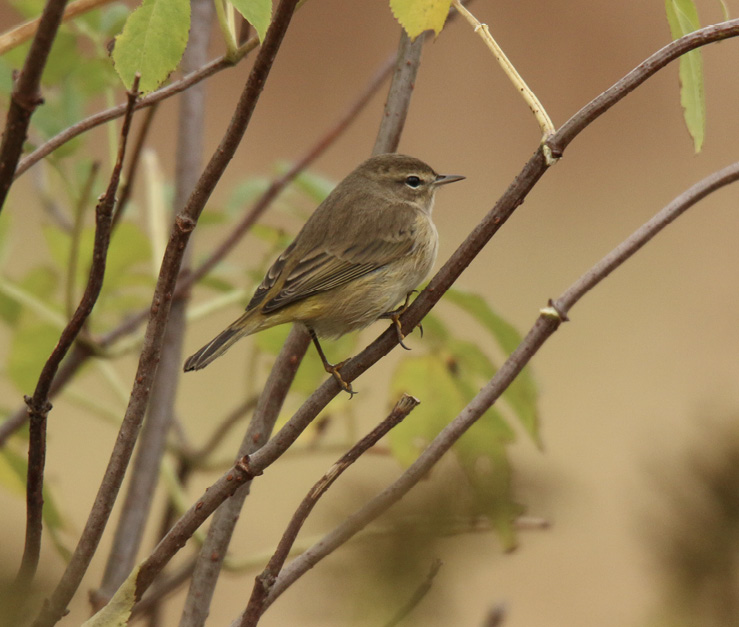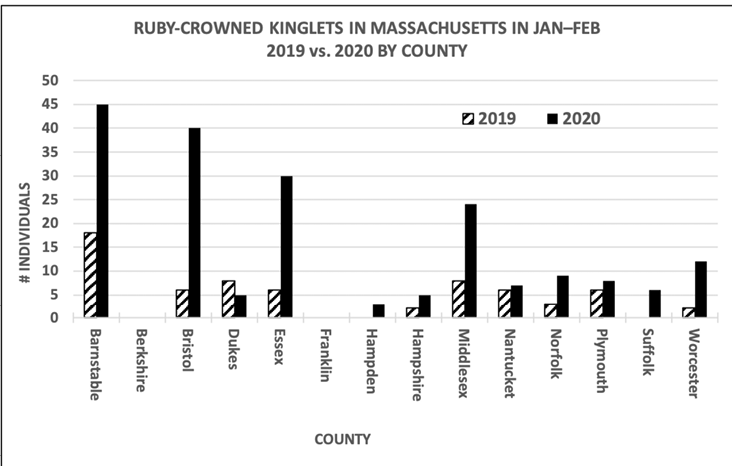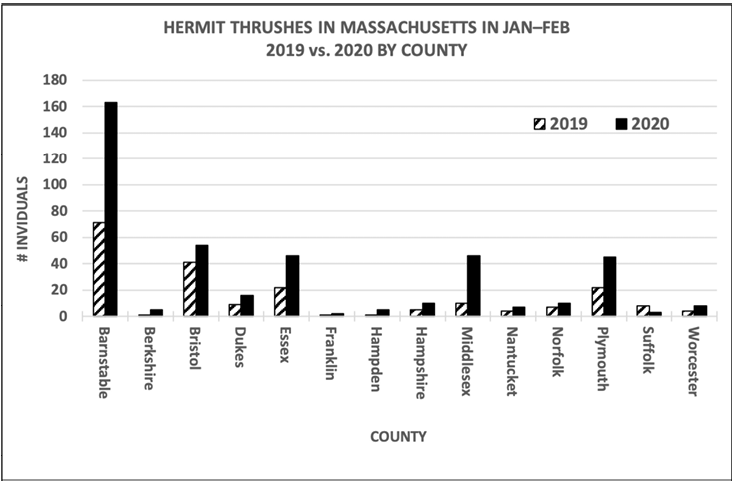Neil Hayward and Robert H. Stymeist
The weather was the highlight for birders during this period. Winter, as defined by meteorologists, is December through February. This winter, the temperature averaged well above normal and snowfall totaled only 15.1 inches, 19 inches below average, with 7.1 inches of that total falling in early December. This warm and nearly snowless winter was a boon for many species, including the human birders who were able to get out and enjoy some comfortable birding.

PALM WARBLER BY NATE MARCHESSAULT
Both January and February were warmer than normal with near average rainfall. Only 3.6 inches of snow fell in Boston compared to 13.7 inches during the same period in 2019. The year opened with clear skies and a high temperature of 43 degrees for those birders ready to start a new year of birding. The temperature for the month of January averaged 38 degrees in Boston, compared with a 30-year average of 29 degrees. The high temperature was an amazing 74 degrees on January 12, setting an all-time record high for the month. It was also the first year in which Boston reached 70 degrees twice during January. The previous record high was 64 degrees, recorded on January 26, 1950.
Neither Punxsutawney Phil nor Ms. G—his Massachusetts counterpart at Drumlin Farm, Lincoln—saw their shadows and so both predicted an early spring. We have to agree that they were spot-on; the temperature averaged 44.8 degrees, six degrees above normal for February. The high mark was 64 degrees on February 24; the low for daytime temperature for Boston was 31 degrees. Rainfall during the month was 2.8 inches, nearly a half inch less than average. Snowfall was a paltry 0.5 inches for Boston, more than 10 inches below normal.
R. Stymeist
GEESE THROUGH IBISES
The fields around Rochester, Plymouth County, continued to be the hotspot for wild goose chases. A pair of Barnacle Geese appeared on January 15 and stayed through the period into March. During their visit, they hopped the border into Bristol County, where they were regularly reported along the Acushnet River. This pair represents the second county record for both Bristol and Plymouth counties, after records in February and March 2003. On February 23, Rochester hosted a Pink-footed Goose, perhaps the same individual that had continued from December until January 5 in the Dighton or Somerset area. Pink-footed Geese have been recorded in the state every year now since 2014. Greater White-fronted Geese were reported from eight counties, including the first for Martha's Vineyard since 2011.
The adult Tundra Swan at Somerset continued from the previous period (discovered on December 7) until January 19. Five adult Tundra Swans in Worcester on February 29 were the first for the county since January 1999.
Since 2010, Blue-winged Teals have been found overwintering in small numbers on Cape Cod. This year, up to four birds (two pairs) were present at Mill Pond in West Barnstable, which represents a new high count for the period. This location has become somewhat of a regular wintering location for the species, hosting up to three birds in 2018 and a long-staying pair in 2019. A count of 30 Redheads on Nantucket on February 16 is the highest February count for the state since 1997. Another high count was logged for Tufted Duck; two birds (male and female) at Harwich for most of the period is a new high count for Barnstable County. A male Tufted Duck continued on Nantucket. The island has hosted a male Tufted Duck annually since 2013. King Eiders were reported from four counties, including a female at Chappaquiddick on January 4, the first January record for Dukes County since 2008.
Duck hybrids included two returning birds: a Bufflehead x Common Goldeneye at Rock Harbor Marsh, Orleans, first discovered in April 2017, and a Common Goldeneye x Hooded Merganser at Oldham Pond in Pembroke, which has been wintering there since January 2017. A Northern Pintail x Mallard hybrid was found on the Charles River at Waltham.
An Eared Grebe spent over three weeks in February off the Beverly coast. This was the first record for Essex County since the long-staying individual that wintered off Eastern Point from December 1995 through March 2008. The only other Eared Grebe in New England this period was a bird just across the Rhode Island state line in Stonington, Connecticut.
Though Sandhill Cranes have become a regular visitor to the state in recent years, with breeding first recorded in 2007, the four birds reported in Medfield and Lancaster represent high counts for both January and February.
The mild conditions this period were conducive to overwintering rails. Soras rarely attempt to winter in the state unlike the hardier Virginia Rail. This year Soras were recorded in January for only the fourth time this century, with Plymouth County adding its first January record at Mass Audubon's Daniel Webster Wildlife Sanctuary. Common Gallinule, another uncommon wintering species, was recorded for just the fifth January this century, with Plymouth and Norfolk Counties adding their first January records.
The warm temperatures were also no doubt responsible for the number of unseasonal shorebird records. The most northerly American Oystercatchers on the continent for the period were three birds at Snake Island, Winthrop, on January 4. They represent the first Suffolk County record for January, and the fifth year this century that the species has been recorded in January in Massachusetts. A Piping Plover seen on Nantucket on February 23 was the only record north of Virginia Beach for the period. Remarkably, this is only the second February record for the state on eBird. The first came the previous year—a bird spotted on Nantucket, less than a mile from this year's bird and on the exact same date. Historically, there are other midwinter records of Piping Plovers (Veit and Petersen, 1993). This was the seventh year this century that Semipalmated Plovers have been recorded in January, almost all of which have been found on Cape Cod. This year, two birds were in Harwich for most of the period. A Marbled Godwit at Plymouth Harbor was the fourth January record this century. Red Knots were reported from Chatham and Rockport, the latter being the first February record since 2008. A couple of Long-billed Dowitchers on January 20 was the first January record for Nantucket, and the fourth January record for the state this century. A report of a Willet on January 3 is only the third January record for the state. The observer noted it was a Western Willet (subspecies inornata), which would be consistent with the wintering distribution of the species; Western Willets winter along the Atlantic and Pacific coasts. "Our" breeding Willets, the eastern subspecies semipalmata, leaves the country entirely to winter in the West Indies and the east coast of South America.
This period saw a major incursion of alcids into our waters. Boat trips to Jeffreys Ledge set a new eBird high count for Dovekie in January with an amazing 820 on January 4, and the second-highest count for February with 635 logged on February 9. Closer to shore, Suffolk County recorded its second January eBird record of Dovekie, with a bird stranded on Winthrop Beach. The 248 Common Murres that flew past Race Point on January 2 was a high count for the month and an all-time high for Cape Cod. Similarly, the 86 Thick-billed Murres reported from Andrews Point, Rockport, on January 25 was a new January eBird high count. In historical terms, these numbers are still a long way shy of the 4,000 Thick-billed Murres that flew past Race Point after a storm on January 16, 1977 (Veit and Petersen, 1993). The pale, arctic breeding mandtii subspecies of Black Guillemot continued at MacMillan Wharf, Provincetown from the previous period. This is the only record of this subspecies in North America so far this year and represents a subspecies first for Massachusetts. On January 14, a boat trip to Jeffreys Ledge sighted 10 Atlantic Puffins, which is the second highest state count for January.
Lynn Beach should add Mew Gull to its tourist signs; it's surely one of the most reliable spots to find the species on the East Coast. This year, two birds appeared, both on the same day—January 31—and stayed throughout much of February. One bird was the returning "Common Gull"—the European Larus canus canus subspecies. This bird has become something of a celebrity. It was banded in Akureyrarflugvöllur, northern Iceland, on June 23, 2013, and has returned to the same spot on Lynn Beach every winter since February 2017. The other bird appears to be the Asiatic form, either the Kamchatka Gull, L. c. kamtschatschensis or the Russian Common Gull L. c. heinei. Elsewhere, Bristol and Norfolk counties added their second records of Mew Gull (subspecies unknown or unreported). On Nantucket a high count of 125 Lesser Black-backed Gulls was impressive.
Pacific Loon is annual to the state, recorded in every month except for August. This year, up to four birds were present off Race Point, which represents a new high count for the state. Single Sooty Shearwaters at Race Point and Stellwagen Bank at the start of January were unseasonal—just the fifth year the species has been recorded in January.
American White Pelican was missed entirely for the state in 2019 for the first year since 2007. But it only took two days for one to appear in 2020—soaring over Truro and Wellfleet on January 2. A month later, a bird was seen swimming on a pond in Wareham.
The only Great Egrets of the period were in February at Chappaquiddick and Chatham, the latter being the northernmost bird reported on the East Coast. A roost of 22 Black-crowned Night-Herons at the Upper Lagoon Pond on Martha's Vineyard is the second highest eBird January count, after a count of 33 also on the Vineyard on January 1, 1995. By the end of February, the roost numbers had dropped to 12. Black-crowned Night-Herons were also reported on the mainland coast north to Portsmouth, New Hampshire. Such attempts at overwintering are usually restricted to mild winters, such as this one. An immature Yellow-crowned Night-Heron, photographed at Chilmark, Martha's Vineyard, on January 2, represents the first state record for January. As an indication for how unusual this sighting is, there appear to be no records in the state for this species between November 1 and March 14, except for an adult in Bourne on February 17, 1965 (Veit and Petersen, 1993).
N. Hayward
VULTURES THROUGH DICKCISSEL
Raptor highlights during the period included high numbers of Black Vultures; in Ashley Falls, southwestern Berkshire County, as many of 26 were counted, while 28 were tallied in Blackstone, along the Rhode Island border. Ten Bald Eagles, nine of which were immatures, were found along the canal at Turners Falls. As many as six Long-eared Owls were reported from areas in East Boston and Revere. There were 15 individual Short-eared Owls reported compared with nine for the same period last year.
For those birds that have been lucky or hardy enough to survive to the start of the winter season, the period after the Christmas Bird Counts can take a heavy toll. Many individuals, including species such as Ruby-crowned Kinglet, Hermit Thrush, Gray Catbird, and Baltimore Oriole don't make it. This year (now through March, as I write this), has been one of the top 10 mildest and snowless winters in official record keeping. The result for wintering songbirds has been a bright picture of survival, as shown in Figure 1.


Figure 1. A comparison between 2019 and 2020 of total wintering individuals of Ruby-crowned Kinglets and Hermit Thrushes in Massachusetts counties for the period January–February. Data from eBird.org.
Among the vagrants were some holdovers from December including the elusive Townsend's Solitaire at Halibut Point State Park. Many birders made several trips before finding it, while others failed entirely. A Western Tanager that was coming to a feeder on Oriole Lane in Sandwich was much more obliging. The birding community is grateful to birders Scott and Sharion Boutilier for graciously allowing access to see the bird on their property. Another rare yard bird, a Varied Thrush, was visiting a feeder in Westhampton. The bird—unbeknownst to the host—was only discovered during a visit by a birding friend.
Other noteworthy reports included a Sedge Wren on Cuttyhunk, a Yellow-throated Warbler in Lancaster, and four individual Painted Buntings coming to feeders. Yellow-breasted Chats were reported in 20 locations. Other winter highlights included Nashville Warbler, Black-throated Blue Warbler, Prairie Warbler, and as many as 14 Orange-crowned Warblers.
R. Stymeist
References
- Veit, R. R., and W. R. Petersen. 1993. Birds of Massachusetts. Lincoln, Mass. Massachusetts Audubon Society.